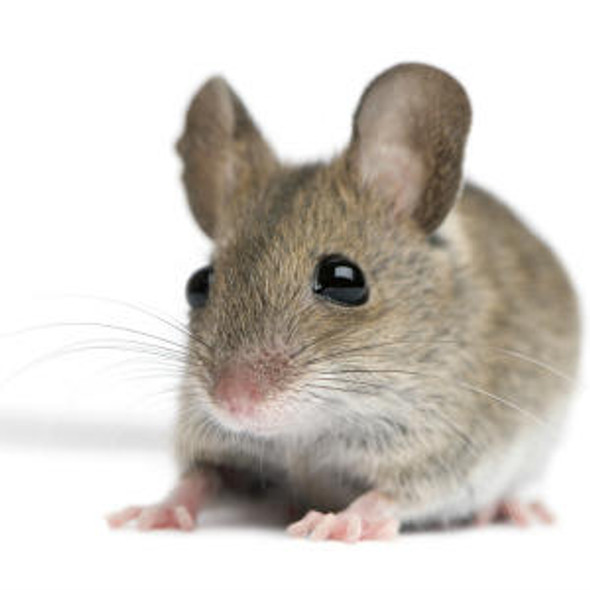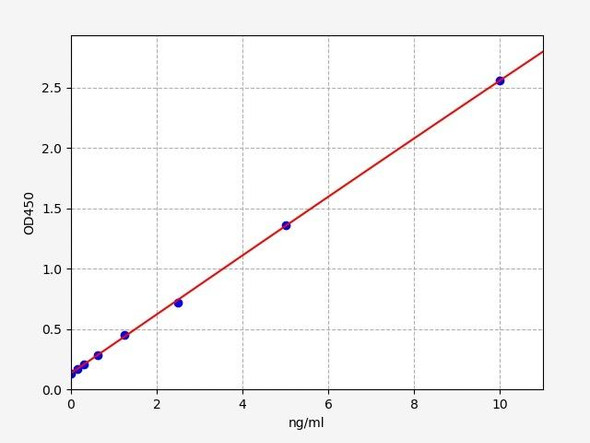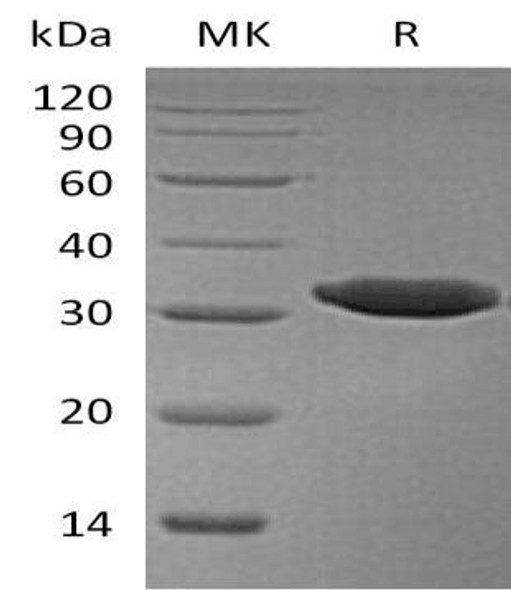Description
Human Neuropathy target esterase (PNPLA6) ELISA Kit
The Human Neuropathy Target Esterase PNPLA6 ELISA Kit is specifically designed for the accurate and sensitive detection of PNPLA6 levels in human samples such as serum, plasma, and cell culture supernatants. This kit offers high specificity and precision, ensuring reliable and consistent results for a variety of research applications.PNPLA6, also known as neuropathy target esterase, is a vital enzyme involved in lipid metabolism and neurological function. Dysregulation of PNPLA6 has been associated with various neuropathies and neurodegenerative disorders, making it a key biomarker for understanding and potentially treating these conditions.
By using the Human Neuropathy Target Esterase PNPLA6 ELISA Kit, researchers can accurately measure PNPLA6 levels in biological samples, allowing for in-depth studies on its role in neuropathy and other related disorders. This kit provides a valuable tool for advancing research in the field of neurology and identifying potential therapeutic targets.
| Product Name: | Human Neuropathy target esterase (PNPLA6) ELISA Kit |
| SKU: | HUEB2211 |
| Size: | 96T |
| Target: | Human Neuropathy target esterase (PNPLA6) |
| Synonyms: | Patatin-like phospholipase domain-containing protein 6, NTE |
| Assay Type: | Sandwich |
| Detection Method: | ELISA |
| Reactivity: | Human |
| Detection Range: | 0.156-10ng/mL |
| Sensitivity: | 0.078 ng/mL |
| Intra CV: | 4.6% | ||||||||||||||||||||
| Inter CV: | 7.7% | ||||||||||||||||||||
| Linearity: |
| ||||||||||||||||||||
| Recovery: |
| ||||||||||||||||||||
| Function: | Phospholipase B that deacylates intracellular phosphatidylcholine (PtdCho), generating glycerophosphocholine (GroPtdCho). This deacylation occurs at both sn-2 and sn-1 positions of PtdCho. Its specific chemical modification by certain organophosphorus (OP) compounds leads to distal axonopathy. |
| Uniprot: | Q8IY17 |
| Sample Type: | Serum, plasma, tissue homogenates, cell culture supernates and other biological fluids |
| Specificity: | Natural and recombinant human Neuropathy target esterase |
| Research Area: | Metabolism |
| Subcellular Location: | Endoplasmic reticulum membrane Single-pass type I membrane protein Cytoplasmic side Anchored to the cytoplasmic face of the endoplasmic reticulum by its N-terminal transmembrane segment. |
| Storage: | Please see kit components below for exact storage details |
| Note: | For research use only |
| UniProt Protein Function: | NTE: Phospholipase B that deacylates intracellular phosphatidylcholine (PtdCho), generating glycerophosphocholine (GroPtdCho). This deacylation occurs at both sn-2 and sn-1 positions of PtdCho. Its specific chemical modification by certain organophosphorus (OP) compounds leads to distal axonopathy. Defects in PNPLA6 are the cause of spastic paraplegia autosomal recessive type 39 (SPG39); also known as NTE-related motor neuron disorder (NTEMND). Spastic paraplegia is a neurodegenerative disorder characterized by a slow, gradual, progressive weakness and spasticity of the lower limbs. Rate of progression and the severity of symptoms are quite variable. Initial symptoms may include difficulty with balance, weakness and stiffness in the legs, muscle spasms, and dragging the toes when walking. In some forms of the disorder, bladder symptoms (such as incontinence) may appear, or the weakness and stiffness may spread to other parts of the body. SPG39 is associated with a motor axonopathy affecting upper and lower limbs and resulting in progressive wasting of distal upper and lower extremity muscles. Belongs to the NTE family. 3 isoforms of the human protein are produced by alternative splicing. |
| UniProt Protein Details: | Protein type:Membrane protein, integral; Hydrolase; EC 3.1.1.5 Chromosomal Location of Human Ortholog: 19p13.2 Cellular Component: endoplasmic reticulum; endoplasmic reticulum membrane; membrane Molecular Function:lysophospholipase activity Biological Process: developmental process; glycerophospholipid catabolic process Disease: Boucher-neuhauser Syndrome; Laurence-moon Syndrome; Oliver-mcfarlane Syndrome; Spastic Paraplegia 39, Autosomal Recessive |
| NCBI Summary: | This gene encodes a phospholipase that deacetylates intracellular phosphatidylcholine to produce glycerophosphocholine. It is thought to function in neurite outgrowth and process elongation during neuronal differentiation. The protein is anchored to the cytoplasmic face of the endoplasmic reticulum in both neurons and non-neuronal cells. Mutations in this gene result in autosomal recessive spastic paraplegia, and the protein is the target for neurodegeneration induced by organophosphorus compounds and chemical warfare agents. Multiple transcript variants encoding different isoforms have been found for this gene. [provided by RefSeq, Oct 2009] |
| UniProt Code: | Q8IY17 |
| NCBI GenInfo Identifier: | 150403921 |
| NCBI Gene ID: | 10908 |
| NCBI Accession: | Q8IY17.2 |
| UniProt Secondary Accession: | Q8IY17,O60859, Q86W58, Q9UG58, A6NGQ0, B4DFB9, B7Z7T2 F5H5K9, J3KQS3, |
| UniProt Related Accession: | Q8IY17 |
| Molecular Weight: | 143,351 Da |
| NCBI Full Name: | Neuropathy target esterase |
| NCBI Synonym Full Names: | patatin like phospholipase domain containing 6 |
| NCBI Official Symbol: | PNPLA6 |
| NCBI Official Synonym Symbols: | NTE; sws; BNHS; LNMS; OMCS; SPG39; NTEMND; iPLA2delta |
| NCBI Protein Information: | neuropathy target esterase |
| UniProt Protein Name: | Neuropathy target esterase |
| UniProt Synonym Protein Names: | Patatin-like phospholipase domain-containing protein 6 |
| Protein Family: | Neuropathy target esterase |
| UniProt Gene Name: | PNPLA6 |
| UniProt Entry Name: | PLPL6_HUMAN |
| Component | Quantity (96 Assays) | Storage |
| ELISA Microplate (Dismountable) | 8×12 strips | -20°C |
| Lyophilized Standard | 2 | -20°C |
| Sample Diluent | 20ml | -20°C |
| Assay Diluent A | 10mL | -20°C |
| Assay Diluent B | 10mL | -20°C |
| Detection Reagent A | 120µL | -20°C |
| Detection Reagent B | 120µL | -20°C |
| Wash Buffer | 30mL | 4°C |
| Substrate | 10mL | 4°C |
| Stop Solution | 10mL | 4°C |
| Plate Sealer | 5 | - |
Other materials and equipment required:
- Microplate reader with 450 nm wavelength filter
- Multichannel Pipette, Pipette, microcentrifuge tubes and disposable pipette tips
- Incubator
- Deionized or distilled water
- Absorbent paper
- Buffer resevoir
*Note: The below protocol is a sample protocol. Protocols are specific to each batch/lot. For the correct instructions please follow the protocol included in your kit.
Allow all reagents to reach room temperature (Please do not dissolve the reagents at 37°C directly). All the reagents should be mixed thoroughly by gently swirling before pipetting. Avoid foaming. Keep appropriate numbers of strips for 1 experiment and remove extra strips from microtiter plate. Removed strips should be resealed and stored at -20°C until the kits expiry date. Prepare all reagents, working standards and samples as directed in the previous sections. Please predict the concentration before assaying. If values for these are not within the range of the standard curve, users must determine the optimal sample dilutions for their experiments. We recommend running all samples in duplicate.
| Step | |
| 1. | Add Sample: Add 100µL of Standard, Blank, or Sample per well. The blank well is added with Sample diluent. Solutions are added to the bottom of micro ELISA plate well, avoid inside wall touching and foaming as possible. Mix it gently. Cover the plate with sealer we provided. Incubate for 120 minutes at 37°C. |
| 2. | Remove the liquid from each well, don't wash. Add 100µL of Detection Reagent A working solution to each well. Cover with the Plate sealer. Gently tap the plate to ensure thorough mixing. Incubate for 1 hour at 37°C. Note: if Detection Reagent A appears cloudy warm to room temperature until solution is uniform. |
| 3. | Aspirate each well and wash, repeating the process three times. Wash by filling each well with Wash Buffer (approximately 400µL) (a squirt bottle, multi-channel pipette,manifold dispenser or automated washer are needed). Complete removal of liquid at each step is essential. After the last wash, completely remove remaining Wash Buffer by aspirating or decanting. Invert the plate and pat it against thick clean absorbent paper. |
| 4. | Add 100µL of Detection Reagent B working solution to each well. Cover with the Plate sealer. Incubate for 60 minutes at 37°C. |
| 5. | Repeat the wash process for five times as conducted in step 3. |
| 6. | Add 90µL of Substrate Solution to each well. Cover with a new Plate sealer and incubate for 10-20 minutes at 37°C. Protect the plate from light. The reaction time can be shortened or extended according to the actual color change, but this should not exceed more than 30 minutes. When apparent gradient appears in standard wells, user should terminatethe reaction. |
| 7. | Add 50µL of Stop Solution to each well. If color change does not appear uniform, gently tap the plate to ensure thorough mixing. |
| 8. | Determine the optical density (OD value) of each well at once, using a micro-plate reader set to 450 nm. User should open the micro-plate reader in advance, preheat the instrument, and set the testing parameters. |
| 9. | After experiment, store all reagents according to the specified storage temperature respectively until their expiry. |
When carrying out an ELISA assay it is important to prepare your samples in order to achieve the best possible results. Below we have a list of procedures for the preparation of samples for different sample types.
| Sample Type | Protocol |
| Serum | If using serum separator tubes, allow samples to clot for 30 minutes at room temperature. Centrifuge for 10 minutes at 1,000x g. Collect the serum fraction and assay promptly or aliquot and store the samples at -80°C. Avoid multiple freeze-thaw cycles. If serum separator tubes are not being used, allow samples to clot overnight at 2-8°C. Centrifuge for 10 minutes at 1,000x g. Remove serum and assay promptly or aliquot and store the samples at -80°C. Avoid multiple freeze-thaw cycles. |
| Plasma | Collect plasma using EDTA or heparin as an anticoagulant. Centrifuge samples at 4°C for 15 mins at 1000 × g within 30 mins of collection. Collect the plasma fraction and assay promptly or aliquot and store the samples at -80°C. Avoid multiple freeze-thaw cycles. Note: Over haemolysed samples are not suitable for use with this kit. |
| Urine & Cerebrospinal Fluid | Collect the urine (mid-stream) in a sterile container, centrifuge for 20 mins at 2000-3000 rpm. Remove supernatant and assay immediately. If any precipitation is detected, repeat the centrifugation step. A similar protocol can be used for cerebrospinal fluid. |
| Cell culture supernatant | Collect the cell culture media by pipette, followed by centrifugation at 4°C for 20 mins at 1500 rpm. Collect the clear supernatant and assay immediately. |
| Cell lysates | Solubilize cells in lysis buffer and allow to sit on ice for 30 minutes. Centrifuge tubes at 14,000 x g for 5 minutes to remove insoluble material. Aliquot the supernatant into a new tube and discard the remaining whole cell extract. Quantify total protein concentration using a total protein assay. Assay immediately or aliquot and store at ≤ -20 °C. |
| Tissue homogenates | The preparation of tissue homogenates will vary depending upon tissue type. Rinse tissue with 1X PBS to remove excess blood & homogenize in 20ml of 1X PBS (including protease inhibitors) and store overnight at ≤ -20°C. Two freeze-thaw cycles are required to break the cell membranes. To further disrupt the cell membranes you can sonicate the samples. Centrifuge homogenates for 5 mins at 5000xg. Remove the supernatant and assay immediately or aliquot and store at -20°C or -80°C. |
| Tissue lysates | Rinse tissue with PBS, cut into 1-2 mm pieces, and homogenize with a tissue homogenizer in PBS. Add an equal volume of RIPA buffer containing protease inhibitors and lyse tissues at room temperature for 30 minutes with gentle agitation. Centrifuge to remove debris. Quantify total protein concentration using a total protein assay. Assay immediately or aliquot and store at ≤ -20 °C. |
| Breast Milk | Collect milk samples and centrifuge at 10,000 x g for 60 min at 4°C. Aliquot the supernatant and assay. For long term use, store samples at -80°C. Minimize freeze/thaw cycles. |









